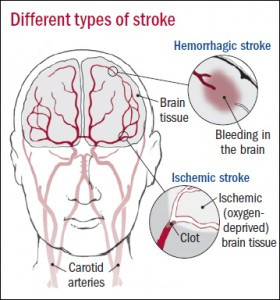Harvard Health Blog
Ultra-rapid treatment reduces odds of post-stroke disability
When it comes to treating stroke, time is brain and every minute counts. That tenet was supported yet again by an international study showing that the sooner clot-busting treatment is begun, the greater the chances of surviving a stroke without a disability.
Writing in the journal Stroke, researchers led by Dr. Daniel Strbian, an associate professor of neurology at Helsinki University Central Hospital in Finland, reported that giving the clot-busting drug alteplase within 90 minutes of the start of stroke symptoms was more effective at preventing long-term problems than giving the drug within 4.5 hours. Current guidelines recommend that a clot-dissolving drug (generally known as a tissue plasminogen activator [tPA]) be administered within 4.5 hours of the onset of symptoms. After 4.5 hours, these drugs are less effective and the risk of bleeding outweighs the small risk of benefit.
Stroke types
Each year, nearly 800,000 Americans have a stroke. Most of them are ischemic strokes. That means they are caused by something blocking blood flow to part of the brain. That something is usually a blood clot. The clot may form in a blood vessel within the brain (causing a thrombotic stroke), or it may form elsewhere in the body and travel to the brain (causing an embolic stroke).
 About 10% of strokes occur when a blood vessel in the brain bursts. This causes bleeding in the brain, and also cuts off blood flow to part of the brain. These are called hemorrhagic strokes.
About 10% of strokes occur when a blood vessel in the brain bursts. This causes bleeding in the brain, and also cuts off blood flow to part of the brain. These are called hemorrhagic strokes.
In the study published in Stroke, patients were divided into three groups based on the severity of their stroke: minor; mild-to-moderate; and moderate-to-severe. Those with mild-to-moderate strokes got the most benefit from ultra-rapid treatment. Less benefit for rapid treatment was seen in those with minor strokes, because they are already at low risk of disability, and in those with severe strokes, probably because their blockages were extensive and more resistant to tPA therapy.
But that’s not to say that patients with severe stroke symptoms shouldn’t be hustled to the hospital and receive early treatment. They, too, should always be considered for intravenous tPA therapy.
In addition to patients’ delaying a call to 911 or trip to the hospital, there’s another factor that can slow the delivery of tPA. A doctor must be sure that the stroke is not caused by bleeding into the brain. To determine that, an MRI or CT scan must first be done.
Brain attack
Strokes, even “minor” ones, are a medical emergency similar to heart attacks. That’s why many experts call stroke a “brain attack.” When one strikes, brain cells die quickly. The faster you recognize a stroke and get to the hospital, the faster treatment can begin. And the greater your chance of near or complete recovery, especially if the symptoms are mild to moderate.
If you suspect that you or someone you are with is having a stroke, think FAST:
- Face: Ask the person to smile. Is one side drooping?
- Arms: Ask the person to lift both arms. Does one drift back down?
- Speech: Ask the person to repeat a simple sentence. Is it slurred or incomplete?
- Time: If one or more stroke signs are present, act quickly. Call 911, and get the person to the nearest hospital with an emergency department. If possible, it should be a hospital with a stroke center.
If you think a stroke is in progress, the best thing to do is to dial 911 or your local emergency number. Let the person on the other end of the line know that you suspect a stroke is happening. That way the emergency department can be ready to do a brain scan.
About the Author

Howard E. LeWine, MD, Chief Medical Editor, Harvard Health Publishing; Editorial Advisory Board Member, Harvard Health Publishing
Disclaimer:
As a service to our readers, Harvard Health Publishing provides access to our library of archived content. Please note the date of last review or update on all articles.
No content on this site, regardless of date, should ever be used as a substitute for direct medical advice from your doctor or other qualified clinician.















